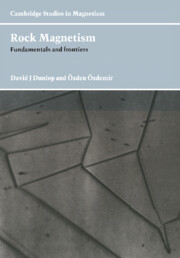Book contents
- Frontmatter
- Contents
- Preface
- Chapter 1 Magnetism in nature
- Chapter 2 Fundamentals of magnetism
- Chapter 3 Terrestrial magnetic minerals
- Chapter 4 Magnetostatic fields and energies
- Chapter 5 Elementary domain structures and hysteresis
- Chapter 6 Domain observations
- Chapter 7 Micromagnetic calculations
- Chapter 8 Single-domain thermoremanent magnetization
- Chapter 9 Multidomain thermoremanent magnetization
- Chapter 10 Viscous and thermoviscous magnetization
- Chapter 11 Isothermal magnetization and demagnetization
- Chapter 12 Pseudo-single-domain remanence
- Chapter 13 Crystallization remanent magnetization
- Chapter 14 Magnetism of igneous rocks and baked materials
- Chapter 15 Magnetism of sediments and sedimentary rocks
- Chapter 16 Magnetism of metamorphic rocks
- Chapter 17 Magnetism of extraterrestrial rocks
- References
- Index
Chapter 11 - Isothermal magnetization and demagnetization
Published online by Cambridge University Press: 06 July 2010
- Frontmatter
- Contents
- Preface
- Chapter 1 Magnetism in nature
- Chapter 2 Fundamentals of magnetism
- Chapter 3 Terrestrial magnetic minerals
- Chapter 4 Magnetostatic fields and energies
- Chapter 5 Elementary domain structures and hysteresis
- Chapter 6 Domain observations
- Chapter 7 Micromagnetic calculations
- Chapter 8 Single-domain thermoremanent magnetization
- Chapter 9 Multidomain thermoremanent magnetization
- Chapter 10 Viscous and thermoviscous magnetization
- Chapter 11 Isothermal magnetization and demagnetization
- Chapter 12 Pseudo-single-domain remanence
- Chapter 13 Crystallization remanent magnetization
- Chapter 14 Magnetism of igneous rocks and baked materials
- Chapter 15 Magnetism of sediments and sedimentary rocks
- Chapter 16 Magnetism of metamorphic rocks
- Chapter 17 Magnetism of extraterrestrial rocks
- References
- Index
Summary
Introduction
All magnetizations are produced by an applied magnetic field, but certain magnetization processes, for example isothermal remanent magnetization (IRM) and alternating-field (AF) demagnetization, are field-driven in a more restricted sense. They are produced isothermally, usually at or near T0, over a time scale of at most a few minutes. They result, in other words, from the sole influence of an applied field. Even this definition is not entirely accurate: τ0 is so much less than ordinary measurement times that thermal fluctuations play some role in practically all field-induced processes. For weak applied fields and small V, Hq or Hf are > H0, and thermal excitation plays a major role (§8.7, 9.4.2).
Isothermal remanences do not carry useful paleomagnetic information. An IRM produced by the geomagnetic field is easily reset by later weak fields of similar magnitude: it lacks paleomagnetic stability. Only isothermal remanences due to strong fields, for instance saturation isothermal remanence (SIRM) and anhysteretic remanence (ARM) produced by the combination of a steady field and a strong but decaying AF, have the requisite stability, and these occur in nature only when outcrops have been struck by lightning and remagnetized. However, the stepwise acquisition or removal of magnetizations in the laboratory is used as a means of erasing NRM's of low stability (AF demagnetization) and of determining the composition and domain structure of mineral magnetic carriers (hysteresis, IRM acquisition, ‘DC demagnetization’, Preisach analysis).
- Type
- Chapter
- Information
- Rock MagnetismFundamentals and Frontiers, pp. 288 - 327Publisher: Cambridge University PressPrint publication year: 1997
- 2
- Cited by



